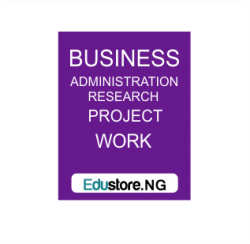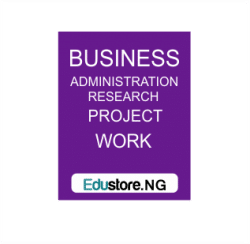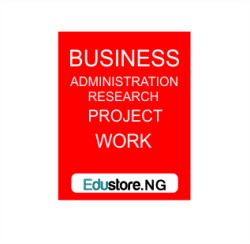AN APPRAISAL OF MATERIAL MANAGEMENT AND RESOURCE UTILIZATION IN AN ORGANIZATION
CHAPTER ONE
INTRODUCTION
1.1 BACKGROUND OF THE STUDY
Material management is an integrated management approach to the planning, purchasing, warehousing, storekeeping, allocation and movement of needed material from source of user department. It can also be defined as the process of management of goods and materials which involved purchasing, storage, control and transportation.
Material and resource management is a relatively new discipline. The 20th century rapid growth and the attendant industrial growth and the attendant shift of production is relative importance of what is usually referred to as the five “m” which includes machine, materials, men money and management.
The famous industrial revolution about the complexity of materials and the volume of productivity which turn and made materials the largest elements cost in every organization.
At the wake of the 20th century many firms had recognized the importance of materials, several materials activities like purchasing, warehousing, stock control and distribution carried out by the organization.
By the 1950s many firms have identified the need for an effective coordination or integration of such material activities and materials organization tools concepts like those of physical distribution movement, logistics movement and material management were involved so as to check, co-ordination and control of the firm’s materials activities. Globally, there is no clear definition because many institutes and writers have given so many definitions in the area for material management.
According to M.A. Tokunbo (1987) define it in the context of store and material control as compensation, the effective coordination of the principle element.
– Identifying, classifying and coordination of stocks.
– Provision, inventory, control and stress accounting.
– Store-house layout and organization
– In house storage, handing and distribution
– Presentation of material in store.
To these, the material manager has the duty of applying the most suitable techniques in the most effective way to ensure the minimum total costs consistent with providing the services required.
The American production and inventory control society (APICS dictionary of production and inventory control terms) define material management and resource utilization as the grouping of management functions related to the complete cycle of materials flow from the purchase and internal control of work in progress of the product, differed from material control in the latter term, traditionally is limited to internal control of production materials. The key words here are material production or manufacturing process.
In examining the whole definition one could easily notice that they are not quite different from one another, but only the way of approach and little different in terminologies. In this respect material and resource utilization management is not only limited to buy and storing as many view it but also include purchasing, transport and distribution, planning and continuous monitoring.
Today materials and resources utilization are the livelihood of any industry, no industry concern can operate without them. They must be made available at the right time. In the right quantity and at the right place.
The subject matter of this study is material management and resource utilization in an organization. The researcher feels it will be of a great important to various enterprise and organization to conduct a detailed study into stores and purchasing material hence, the researcher aim at identifying the problem for efficient operation in an organization.
The researcher is interested in knowing how material management and resource utilization function act practicable in an organization. As a result of the sophistication in technology at parent coupled with social economic and political changes. Activities could no longer be run without problem and adhoc basis but must be planned moreover when problems are complex in nature by management there is a need to ensure that materials and resources are allocated and used in the most efficient and effective way.
The material management and resource utilization function is also to identify problems by guiding against sub-optimization of the material and resources (under utilization of organizational resources) for this the researcher assist to and acceptable.
Seven-up brand roots go back to 1i920 when C.L. Gregg banked on his 30 years of experience in advertising and merchandising to form the howdy corporation in St. Louis, although he named the company after the Howdy Orange drink he pioneer, goal was to create a wholesome and distinctive soft drink that would prove irresistible to the nation’s consumers.
Gregg spent more than two years testing different formulas of lemon flavored drinks. He settled on one that fulfilled the characteristics sought refreshing, and thirst – quenching. Gregg introduced his new soft drink two weeks before the stock market crash in October 1929.
The earliest Seven-up advertising featured a winged 7up logo and described the soft drink in bottles only seven natural flavors blended into a savory, flavor drink with real wallop Acknowledgement the success for the seven-up trademark bottling company plc was founded in 1959s, seven-up has become the third best selling soft drink in the world.
While in Nigeria, seven-up bottling company plc was founded in 1959 by late Sheikh Mohammed El-Khalil, at Ijora Lagos. Production started on October 1st 1960.
The company brands include Seven-Up, Pepsi, Mirinda (orange, soda tonic, pineapple, green apple) mountain dew and teen lemonade.
The organization had nine operational plants branches across Nigeria which are as follow: Ikeja plant, Ibadan plant, Benin Plant, Ilorin Plant, Enugu Plant, Aba plant, Abuja plant, Kaduna plant, and Kano plant.
The head office of Seven-Up Bottling Company Plc is at Ijora Apape area in Lagos State.
Kaduna Plant which is the plant been used for the case study is situated at Kaduna South, industrial area along Inuwa Abdulkadir road.
The company is committed to a culture of excellence in all their activities. Hence they strive to position the company to meet and exceed the expectation of the employees, customers, suppliers, shareholders, government and its agencies including the general public.
1.2 STATEMENT OF THE PROBLEMS
Seven-Up Bottling Company Plc as an organization is faced with problems in relation to utilization of material and resources being the utmost thing that are needed to be utilized effectively. The problems facing the material management and resource utilization especially Seven-Up Bottling Company Plc are mainly overstocking or under stocking of materials, obsolescence’s breakage and the economic order. Due to the fact that functions of many purpose, the impact felt positively in the society by making themselves reasonable in every area of inputs.
But despite the material management and resources utilization as a tool for optimal utilization in Nigeria is not notice because it was observed that it is a general apathy” ignorance and lack interest by many people in the country. Many of the people including the government, individual are having the wrong nation and wrong impression.
1.3 OBJECTIVES OF THE STUDY
The major objectives of the studies are as follows:-
1. To find whether the company use accounting tools and techniques
in maintaining their materials.
2. To find how Seven -Up Bottling Company Plc managed their
material efficiently.
3. To find out how resources are been utilized
4. To find out whether there is wastage of material or not
5. To look at the significance of materials management and utilization
of resources in manufacturing.
1.4 STATEMENT OF HYPOTHESIS
Ho Material Management and Resource Utilization cannot improve productivity in an organization.
HI Material Management and Resource Utilization can improve productivity in an Organization
1.5 SIGNIFICANCE OF THE STUDY
The significance of the project is designed to help business, institutions or an organization to analyses and reduce excessive cost in all areas of it operations. In today’s business climate, with keener competition and
Unstable economic condition, the sustained controlling of cost often means the different between profit and loss all over the world, cost conscious executives, purchasing managers in institution etc.
More so it is of a great significance to the manufacturing industries, that is, the project is of great importance because it is possible to evaluate the efficiency of material management and resources utilization.
Material management and resources utilization is compendium concept of the best cost controlling ideas and methods that have evolved in recent year. Material manger, purchasing department will find these project useful ideas that can be directly applied to reduce costs within the organization.
Thus, the project may be of immense help to all business, institution and to those organizations that are faced with the problem of material management and resources utilization been the utmost resources that are needed to be utilized effectively.
1.6 SCOPE OF THE STUDY
The scope of this study has to do with the importance of materials management and resources utilization in Seven-Up Bottling Company Plc as a case study.
1.7 LIMITAIONS OF THE STUDY
This research work is limited to the following department found in Seven-Up Bottling Company Plc.
Personnel Department: This department is responsible for recruitment of skilled, semi skilled and unskilled personal for the entire various department in the organization: It’s also look into the general welfare of the workers and the overall organization operation.
Production department, they are responsible for preparation f schedule for production when to start the production for a particular product (flavor) and also determine the expected quantity material utilization and also a management of jobs.
Accounting Department, this department is responsible for the settlement, of invoices release, casting of material for the purpose of final account or determination of production cost.
Quality control department, this department is responsible for making sure that goods (products) and service are examined to conform to predetermined standard, these department comprises of section such as water treatment, syrup room and laboratory.
Store department, the department has to or renders. Some function to the organization, which area:-
i. To make provision for a balance flow of raw materials that is necessary to meet operational requirement.
ii To make available the maintenance of materials, spare part as well as general store requirement of materials, spare part as well as general store requirement.
Warehouse, warehouse is the department responsible for receiving finished goods from the production department and them forward the some finished product (goods )to marketing department, marketing department are mainly responsible for sales, that is selling the company products at the company recommended price to the various customers.
Feet/ workshop, they are responsible for the transportation, services and repairs for the various company vehicles especially the sales trucks and other vehicles.
In writing a project research works, one is bound to face some certain constraints that will limit the extent to which the research may intend to cover such as:
i. Time: Time is the most affecting constraints to this project in fact, have enough time to write his project work.
ii. Financial Constraints: This is another constraint which hinders the researcher from carrying out his research work on time, especially the recent federal government economic programme which made it difficult for the researcher to source for funds on time; it has slowed down the progress of the project.
1.8 DEFINITION OF TERMS
i. MAINTENANCE: It is the scientific utilization of Resource which includes material, machine, men, method and money to accomplish task, its embrace planning, organization directing, and coordinating.
ii. MATERIAL MANAGEMENT: It is concerned with the flow of materials to manufacturing department; it can be described as a coordinating Function responsible for planning and controlling of materials flow. Material management is an aspect of grouping together under some of finished products; some of these activities may include: purchasing, Inventory control, expenditure warehousing and receiving materials.
iii. PLANNING: Koontz O. Donnell and Welf Rich (1989) Perceive planning as deciding in advance what to do, how to do it when to do it. Planning bridges the gap for where we are to where we want to go. A plan established objective can be attained considering various aspects of the environment and determines the amount of resources necessary.
iv. RESOURCES:- Resources are divided into human and material resources, the human resources is the man power that controls the activities of the organization while the material resources are the assets or wealth of the organization that is put into use in achieving the organization aim.
v. ORGANISATION: This is a systematic ordering of position which determines chains of command or it is an organized group of people working together towards a common ideal and aspiration of the group and putting effect together towards achieving an objective.
vi. OBJECTIVES:-These are the specific productivity on organization wants to achieve in other words it could be seen as asset aside goals in which an organization work towards to achieve effectively and efficiently. No organizations come into existence without having an objective to achieve.
vii. UTILIZATION:- To make the best use of resources efficiently.
viii. PURCHASING:-Purchasing is a strategic activity in an organization with primary objective of improving and maximizing profit it figure out new ideas for improving company’s products, search for belter source supply funds, substitute materials that are more economical.
ix. PURCHASING ORDER FORM: This is legal document normally printed to transmit the organization requirement to the suppliers. This form varies from organization to organization in size, shape and layout. Content and number of copies, however certain essential elements are common.
x. PURCHASING REQUISITION FORM:- This form is usually prepared when a department or store needs a particular materials. Normally three copies are prepared, two copies being sent to the purchasing department as on authority of purchasing and the duplicate being retained by the originating department for reference and follow-up.
xi. ENQUIRY AND QUOTATION: – When competitive tender are required. It is customary to send an enquiring to the suppliers and to receive quotation from the suppliers in order to select the most suitable by analysis of the tenders that are been received.
xii. NEGOTIATION:- It is a decision making process, that is it is a process of planning, reviewing and analyzing by buyer and a seller to reach acceptable agreement or compromise through common understanding.
DOWNLOAD COMPLETE WORK- For Reference Only: Materials are for research, citation, and idea generation purposes and not for submission as your original final year project work.
- Avoid Plagiarism: Do not copy or submit this content as your own project. Doing so may result in academic consequences.
- Use as a Framework: This complete project research material should guide the development of your own final year project work.
- Academic Access: This platform is designed to reduce the stress of visiting school libraries by providing easy access to research materials.
- Institutional Support: Tertiary institutions encourage the review of previous academic works such as journals and theses.
- Open Education: The site is maintained through paid subscriptions to continue offering open access educational resources.






